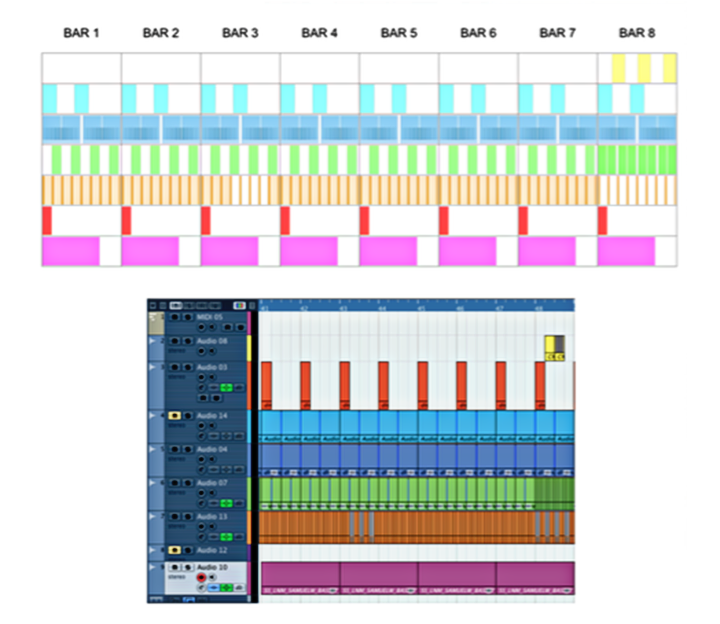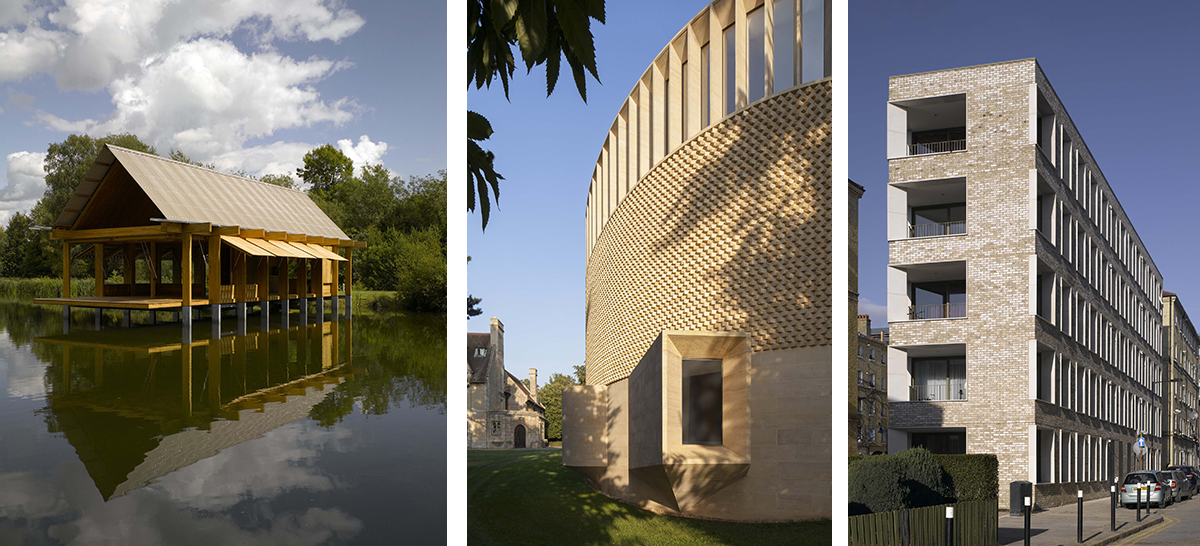THERE IS MUSIC IN EVERY BUILDING
SEPTEMBER 2019

Back in March, I was lucky enough to take part in the annual TEDxCambridgeUniversity conference as one of the 14 speakers. Whilst daunting, this presented a wonderful opportunity to explore and develop my personal interest in architecture and music and how they might interrelate.
I am passionate about both subjects and have long since had a hunch that they are linked. This notion centred around the idea that both architecture and music are composed of layers. On further investigation, numerous parallels became apparent despite the fundamental difference that architecture is visual, physical, and music is aural, intangible.
They share common language – structure, rhythm, harmony, texture, form and so on.
They are both compositions. Architectural composition is the arrangement of building components in space, sensed with our eyes. Musical composition is the arrangement of sounds in time, sensed with our ears.
Architecture is given its distinctive quality or character through choice of materials – stone, brick, timber, glass and so on. The musical equivalent is the range of instruments and sounds available to a composer – piano, strings, brass, percussion for example.
Architectural drawings are like sheet music, one instructing builders on how to construct a building and the other instructing musicians on how to perform a piece of music. In this way, a busy building site resembles an orchestra.
In considering the relationship, one can’t go too far without referencing Johann Wolfgang von Goethe’s famous 18th century quote that “Architecture is frozen music”. This suggests solidifying, giving physical presence to sounds and led me to another line of questioning – can we translate the visual, physical, spatial components of architecture into the aural, intangible, time-based components of music? Can we look at a building and hear its music?
To help find answers, I contacted my brother – an electronic music producer – and we agreed to work together on a musical representation of a façade designed by this office – West Court for Jesus College Cambridge. It lends itself well to the test as there is a clear rhythm and well-defined order to the visual composition.
We considered each bay of the façade as a bar in the music with each layer of the façade translated into a different musical component. Repetitive structural brick piers were translated to a beat. The stone fins added to the rhythm as another layer of percussion. The first floor windows were represented as piano chords, setting the groove and reinforcing the meter of the composition. The two floors above were translated into layers of melody, and the hidden foundations dictated the bassline.
The exercise was intended to be diagrammatic. My brother had many ideas about how to make a better piece of music but for me, the legibility of the translation was key. We could have pushed it further, giving more thought to which sounds or instruments might be best suited to different materials for example.

A lot has been written about the links between Classical architecture and music but I am more interested in the here and now. We are in a technological revolution. With the introduction of computers as a compositional tool over the last few decades, I think it is more apparent than ever that both contemporary architecture and music involve the organised, now computer-aided repetition of a series of components.
Today the primary instrumental music is Electronic. It is generally composed on a computer and it is this computer that “performs” the piece, creating the final “recording”. It is still the case that most buildings today are built, or at least put together, by hand, but change is afoot. The use of 3D printing, drones and even robots on building sites hints at a future in which computers replace humans as the “performers” in construction.
If we think about the classical music of the past in terms of the classical buildings of the past, we can align its melodies and orchestration with ornament, craft, organic sculptural form. Contemporary architecture is closer to electronic music. For some this will have negative connotations but it is important to recognize the full spectrum, from the mundanity of elevator music (or Muzak), to the ubiquity of pop music, and on to the progressive sounds of electro, house, techno and so on. As computers continue to have more impact on the way we practice, architects must embrace their potential in the same way music producers have, striving to be more Techno than Muzak.
To view the talk please click here.
A STYLE FOR OUR TIMES?
NOVEMBER 2015

“The way to make good architecture – that is, to respond with dignity to the relentless jostling of theoretical positions and of the buildings themselves – can be to say very little indeed and just to enquire into what a particular place might, by way of buildings, most need”
Niall Hobhouse in Translations: Florian Beigel and Philip Christou, Christoph Merian Verlag 2014
Each year the Stirling Prize shortlist sparks debate about contemporary architectural style and it was no different this year, particularly with such a distinctive set of buildings. The prize is “presented to the architects of the building that has made the greatest contribution to the evolution of architecture in the past year” and so any building shortlisted could be considered to exemplify a style for our times.
In practicing architecture I have been conscious of past and present styles or trends and how these influence design. The offices I have worked in each have different design styles and a different set of architectural references. This variety has enriched my experience of design; as a result, I do not consider myself to have a fixed stylistic agenda or claim a particular preference for one style over another.
I have now been at NMLA for almost a year, working on one project but well aware of the rich variety in the practice’s past and present portfolio. Whilst there may be a discernible common language in the architecture, I would say this transcends any one particular style. To pick three of the most celebrated projects, the Chapel at Ripon College is very different to the Fishing Hut which is very different to Darbishire Place. Of course these buildings have different briefs but perhaps their ‘style’ is most significantly determined by the ‘place’ they inhabit (where ‘place’ refers to location and context – physical, social, historical and political).
The Chapel sits on a sensitive site. It must respond to its bucolic setting in a clearing amongst trees, the historically-significant college building stock behind and the views to and from the valley below. The Clipsham stone is in keeping with the Limestone of the other college buildings. The smooth base helps ground the building in its natural setting whilst the rough-cut dog-toothed stone alludes to the craft evident in the historic buildings nearby and has an organic quality whose textured surface perfectly captures the shadows of the trees. The clerestorey windows glow as a halo and act as a beacon on the hill when seen from the valley below. Rowan Moore described the chapel as sitting “comfortably amid Cotswold scenery and gothic revival architecture”.
The Fishing Hut is set in the landscape, between water and sky. Its simple form and construction are familiar to rural or agricultural settings but the level of craft and its quality materials make it delightful for the user, elevating it beyond purely functional. With its operable screens and shutters, it is both solid and transparent, as much about shelter, security and shade as it is about light, air and opening up to the landscape it inhabits.
At Darbishire Place the new brick block reflects the massing and characteristics of the existing Peabody estate blocks. The brick selection and white precast concrete window surrounds complement the brick and white-painted window reveals of the Edwardian buildings around the courtyard. Inset balconies enable the new façades to have a flatness akin to those of the surrounding buildings. A simple kink in building’s footprint allows the block to work with its context on both sides – a longer elevation addresses the street while a more compact elevation works with the proportions of the other courtyard façades. This kink also provides a route in from the street and so the new block can complete the courtyard without closing it off.
In terms of these three buildings, it is perhaps more difficult to identify a common architectural language than to comment on how they respond to place. I think they are all concerned with light and shadow and each display a level of craft in their execution. For me though the architecture of each project has a fineness. The fragile crown of stone fins and frameless clerestorey windows at the top of the chapel; the intricate timberwork, lightweight permeable envelope and the slight cantilevered deck hovering over the water to the front of the fishing hut; and the open corners and slender corner posts containing the inset balconies to Darbishire Place. It is these moments of finesse that unite the three buildings and other projects in the office.
Style has played an important and often polemical role in the development of architecture over the last 150 years. However, whilst we can entertain debate about a cycle of trends in design, what style is ‘now’ and what is coming next, it seems more pertinent to be aware of the wide variety of styles and take influence from sources that are most appropriate to any one project’s place.
In the same vein as the opening quotation, we should not be concerned with a particular style for a particular time, but rather a particular style for a particular place.


